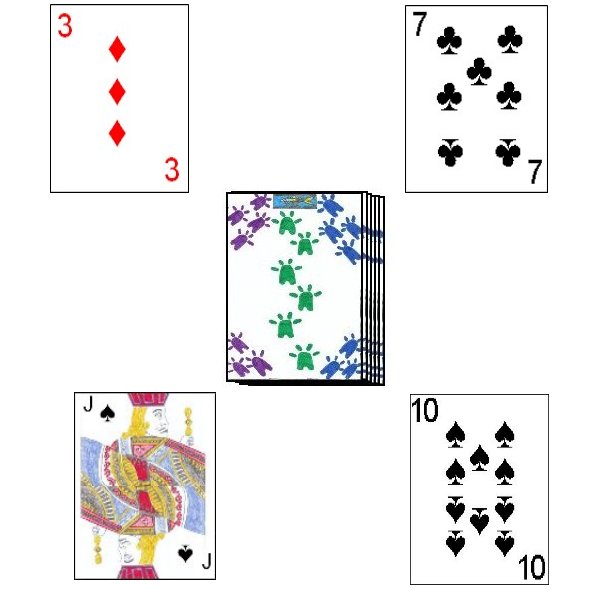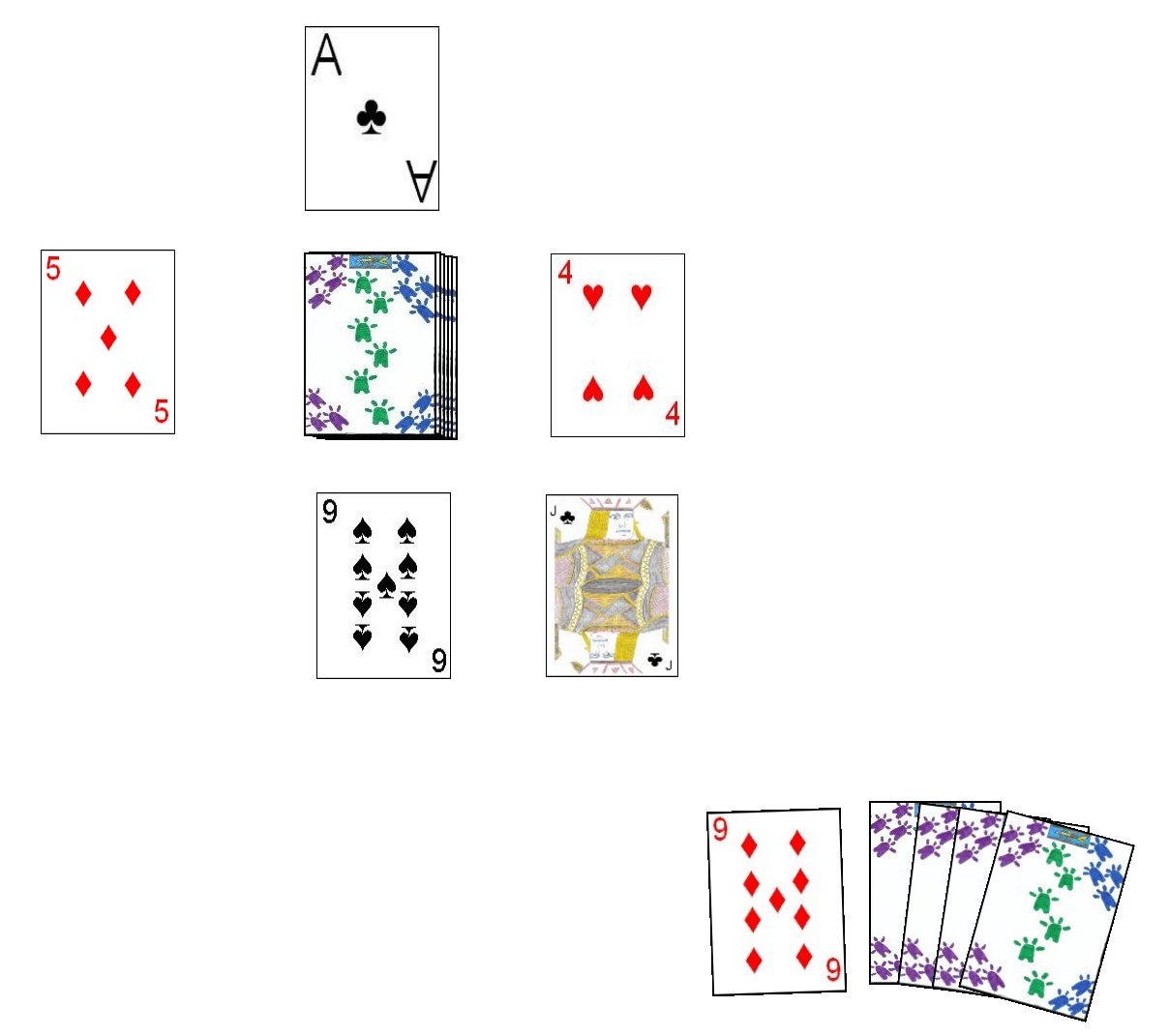Chinese Ten, also known as Pick Up Red Spots, is the most popular of a group of Chinese games in which the usual objective is to capture certain cards from a central layout. Chinese Ten uses one standard 52 card deck and is designed to be played by from 2 to 4 players.
Selection of seating positions and first dealer can be using a variety of methods, with drawing for high card common. Once this has been determined, the dealer shuffles the cards and offers the deck to his left hand neighbor to cut. After the cut, the dealer then distributes the necessary cards to the players in a counter-clockwise direction. The initial number of cards dealt is directly dependent on the number of players as shown in the following chart:
| Number of Players | Cards Dealt |
|---|
| 2 | 12 |
| 3 | 8 |
| 4 | 6 |
 |
| An example of the initial layout created at the start of a hand of Chinese Ten. |
After dealing the required number of cards to each player the dealer then creates a layout in the center of the table. This layout consists of four face-up cards on the table with the remainder of the face-down deck in the center (called the stock pile). In the rare event that all four cards dealt to the center layout are of the same denomination, the dealer may capture all four of these cards and replace them with four more cards from the stock. If they again are all of the same denomination, he repeats the procedure.
Play begins with the first player to the dealer's immediate right. This player then selects any card from his hand and plays it to the table. The goal of the player on his turn is to capture a card from the center layout using a card from his own hand. He can do this in two ways:
- Cards of denomination 10, Jack, Queen and King can be captured by another card of the same denomination. Usually only one card can be matched in this way, however if there are exactly three cards of the same denomination already in the layout, all three can be captured by the fourth.
- An Individual card of denomination Ace (equaling a value of 1) to 9 on the table can be captured by creating a total of 10 with a card from the player's hand.
When making a capture, the capturing player takes the captured card and
the appropriate card from his hand and sets them in his own separate capture pile,
used later to determine his score for the hand. If, on his turn, a player
cannot make any captures, he simply plays one card from his hand face-up
to the table. After finishing his play, a player then finishes his turn
by flipping over the top card of the stock pile and placing the card face
up on the table. If this card can capture another card from the table,
the player is entitled to take both cards and add them to his own capture pile. The turn then rotates to the next player in a counter-clockwise direction.
The game continues in this manner until the stock card has been depleted and the current player finishes his turn. At this time, each player then sorts through his captured cards and scores a number of points based on specific cards captured, according to the following chart:
| Card Captured | Point Value | Notes |
|---|
| 2, 3, 4, 5, 6, 7, 8 of Diamonds (♦) or Hearts (♥) | Value Marked on Card | - |
| 9, 10, Jack, Queen, King of Diamonds (♦) or Hearts (♥) | 10 | - |
| Ace of Diamonds (♦) or Hearts (♥) | 20 | - |
| Ace of Spades (♠) | 30 | Only applies with 3 or 4 players, otherwise scores 0 |
| Ace of Clubs (♣) | 40 | Only applies with 4 players, otherwise scores 0 |
All other cards have a scoring value of 0. The game continues until, at the end of a hand, one or more players reaches or exceeds a certain score. This score differs depending on the number of players participating in the game:
| Number of Players | Total Points Needed to Win |
|---|
| 2 | 105 |
| 3 | 80 |
| 4 | 70 |
At this time, the player with the highest score is declared the winner. If two or more players reach or exceed the necessary score, they tie as winner of the game.
Chinese Go Fishing: Chinese Fish is another game of the Chinese Fishing family of games, but is played somewhat differently than standard Chinese Ten. It appears to be a variation that is played in several specific areas of China. Chinese Go Fishing has similarities to the card game Cassino.
The standard 52 card deck is used for playing this game and the setup and deal is similar to standard Go fish, with each player receiving a hand of five cards. This game is usually played by 2 to 8 players. The remainder of the deck is then set in the middle of the table. Five additional cards are then taken from the stock and placed face up in the center of the table, around the stock.
The player to the immediate left of the dealer takes the first turn. The object of play is to capture the face up cards from the center layout which will be worth points at the end of the hand. On his turn a player attempts to select a card from his hand which one or more of the face up cards on the table can exactly sum to. The player may capture each card or set of cards that forms this sum. The following chart shows the numerical value of the cards for purposes of summing as well as that cards scoring value after a capture (detailed below):
| Card Denomination | Value Used in Summing | Scoring Value |
|---|
| 2 to 10 | Value Marked on Card | 10 |
| Jack | 11 | 20 |
| Queen | 12 | 30 |
| King | 13 | 40 |
| Ace | 14 | 50 |
|
|
 |
| In this example layout for the game Chinese Go Fishing, the player could capture three cards in playing his nine; The five of Diamonds, four of Hearts and nine of Spades. |
|
For example, a player might have a 9 in his hand. With this card, he could capture a 4 and 5, another 9, a seven and 2 and any other combination of cards which would sum to 9. After making a capture, the player takes all the captured cards from the table and places them in a pile of his captured cards. He also adds the card he used to make the capture to the same pile. If a player is unable to (or elects not) to make a capture on their turn, he must simply select any card from their hand and add it to the center layout. To complete a players turn, they would draw one card from the stock to restore their hand to five cards. If before a players turn, there is less than five cards in the center layout, they may turn enough cards from the stock to ensure there are five face up cards in the layout. When the stock is exhausted, the play continues, however players do not draw a card at the end of their turn and, similarly, the face up layout may end up with fewer than five cards.
The game ends when the stock is exhausted, and all players have played the last card from their hands. The players then add up the scores (as per the chart above) for all cards they have managed to capture during the hand and the player with the highest total is declared the winner. If two or more players tie for the highest score, the game is a tie.
Red Frog, Black Frog: Red Frog, Black Frog (also called Gob Dum, Gob Dang) is a variant of Chinese Ten that is played in Thailand. It is played identically to Chinese Ten with the only difference being in the scoring. The following shows the complete scoring list to be
used when playing Red Frog, Black Frog:
| Captured Card | Scoring Value |
|---|
| 2, 3, 4, 5, 6, 7, 8, 9 of Spades (♠) or Clubs (♣) | Value Marked on Card |
| 10, Jack, Queen, King of Spades (♠) or Clubs (♣) | 10 |
| Ace of Spades (♠) | 50 |
| Ace of Clubs (♣) | 0 |
All other cards are worth 0 points.
Play Red: Play Red (also called Main Merah in Chinese) is another
variant of Chinese Ten. Play Red is designed to be played by two or three players using one standard 52 card deck.
This game is played identically to Chinese Ten with the following differences:
- The number of cards dealt to each player is slightly decreased. In the three player variant of Play Red each player is initially dealt 7 cards and for the two player variant each player initially receives 10.
- A much larger number of cards are added to the initial layout. In the three player variant, 12 cards are arranged face-up to the center layout to begin while in the two player variant the center layout consists of 10 face-up cards.
- If the central layout consists of three or four Fives, Jacks, Kings or Queens the hand is considered dead. No play or scoring occurs on the hand and all cards are thrown in and a new hand is dealt.
- The dealer has the first turn on the first hand and for each hand after the first, the player who had the lowest score on the previous deal becomes the dealer for the next hand and plays first in the hand.
- The scoring value for the cards in Play Red is as follows:
| Captured Card | Scoring Value |
|---|
| 2, 3, 4, 5, 6, 7, 8 of Diamonds (♦) or Hearts (♥) | Value Marked on Card |
| 9, 10, Jack, Queen, King of Diamonds (♦) or Hearts (♥) | 10 |
| Ace of Diamonds (♦), Ace of Hearts (♥) | 20 |
| All Cards of Suits Spades (♠) and Clubs (♣) | 0 |
In all other aspects, Play Red is played identically to Chinese Ten.
Chinese Ten - Simplified Scoring: Some
players prefer to update the scoring in Chinese Ten such that each card
captured has a scoring value. This variant is commonly played in the
Western Hemisphere. The following chart shows the updated scoring:
| Captured Card | Scoring Value |
|---|
| 2, 3, 4, 5, 6, 7, 8 or 9 of any suit | 10 |
| 10, Jack, Queen or King of any suit (Called a Royal Capture) | 20 |
| Any Ace | 15 |
This variation also makes several changes to the basic gameplay as follows:
- Each player receives a total of 6 cards to form his initial hand.
- Direction of play in this variant moves in a clockwise direction from player to player.
- A game consists of a number of hands as there are players in the game, with each player dealing exactly one time. After this number of hands is played, the player with the highest total score is declared the winner.
In all other aspects this variant is played identically to standard Chinese Ten.
Copyright © 2015
CatsAtCards.com. All rights reserved.

